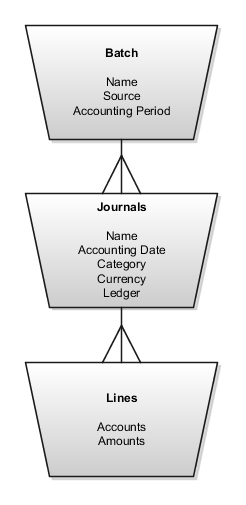Journal Entry Components
Journal entries post accounting balances to the ledger for reporting and analysis.
Journal entries consist of three components: a batch, journals, and lines. You can organize journals with common attributes into batches. The journal information identifies common details for a single journal entry. The lines specify the accounting information for the journal entry. Batches can multiple journals and journals can have multiple lines.
The following figure shows the three journal components and the data required for each component.

Batch
A batch can contain multiple journals, each of which can belong to a different ledger. All of the ledgers within a batch must have the same accounting calendar and chart of accounts. Batches require a name, source, and accounting period. All journal entries in a batch must share the same period. You can create a journal batch by entering a user-defined name in an open or future enterable accounting period. You must post batches in open accounting periods. If you don't want to enter the batch information, start by entering data in the Journals section on the Create Journal page. The batch name is created automatically using the following components:
-
Journal source name of manual
-
A unique batch
-
System date
Journals
A journal requires the following data:
-
Ledger name
-
Journal name
-
Accounting date
-
Source
-
Category
-
Currency
To select the ledger from the choice list, your data access set must provide one of the following
-
Read and write access to the ledger
-
Read and write access to one or more balancing or management segment values
If you use reporting currencies or secondary ledgers with a journal or subledger conversion level, select a reporting currencies or secondary ledger for your journal. Creating manual journals is an exception for the secondary and reporting ledgers because their journals propagate directly from their primary ledger.
Lines
The lines require accounts and amounts. Total debits must equal total credits for all journal entries except for statistical journal entries.